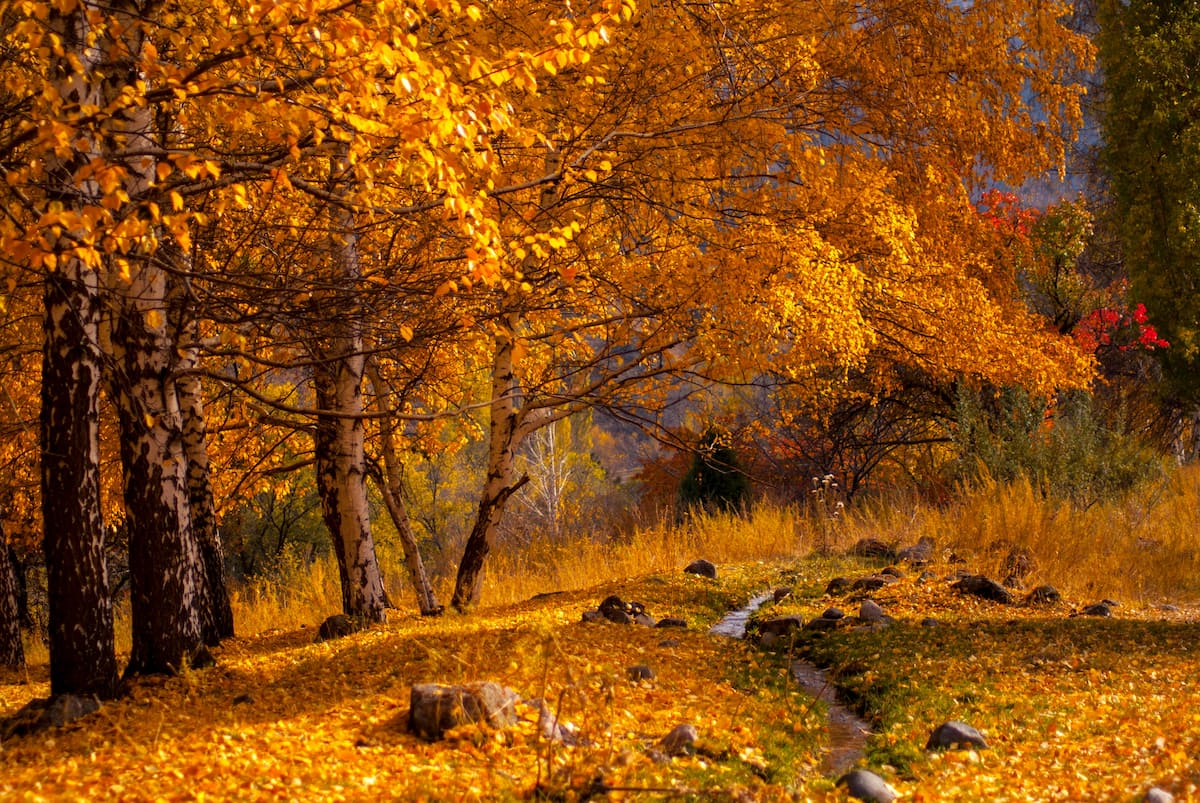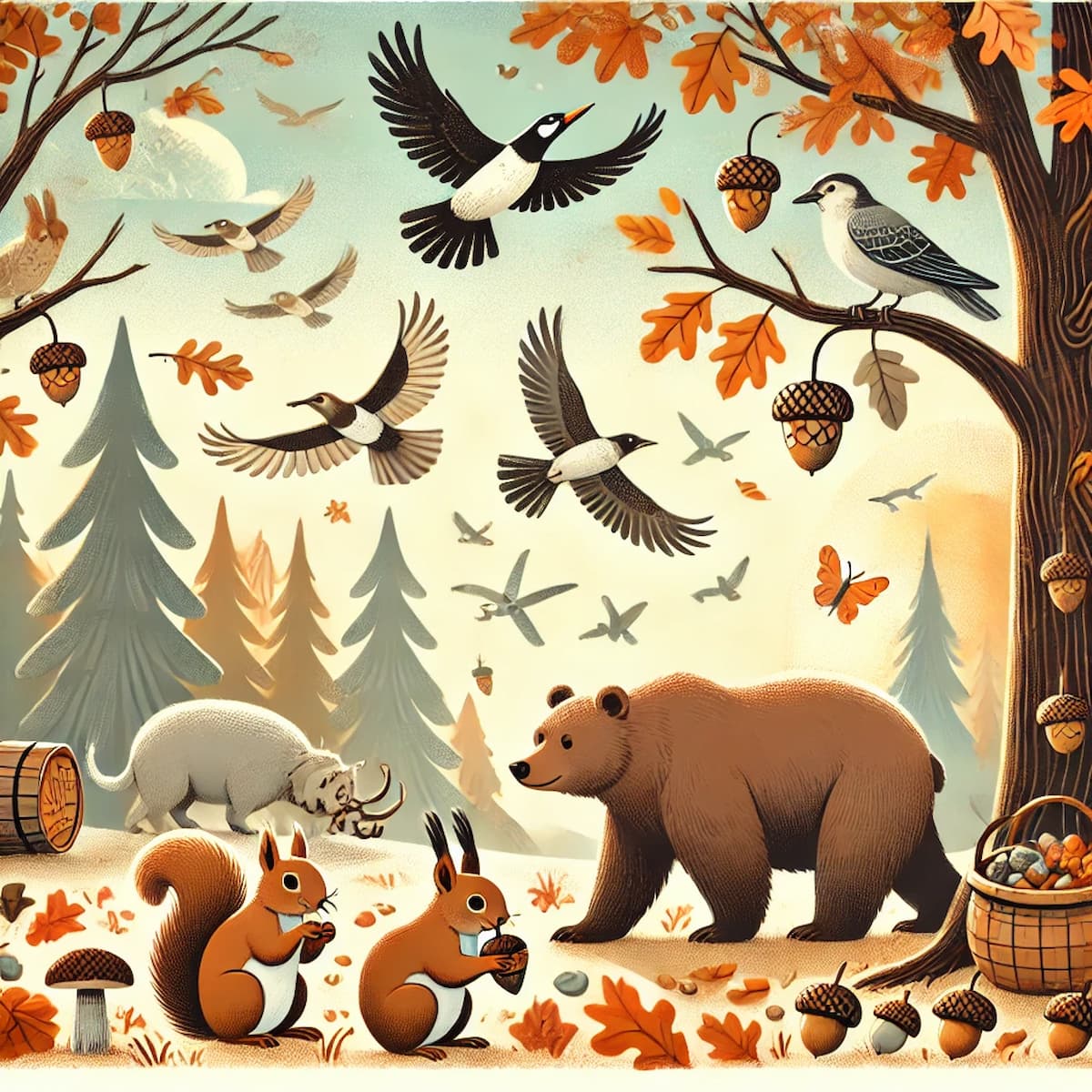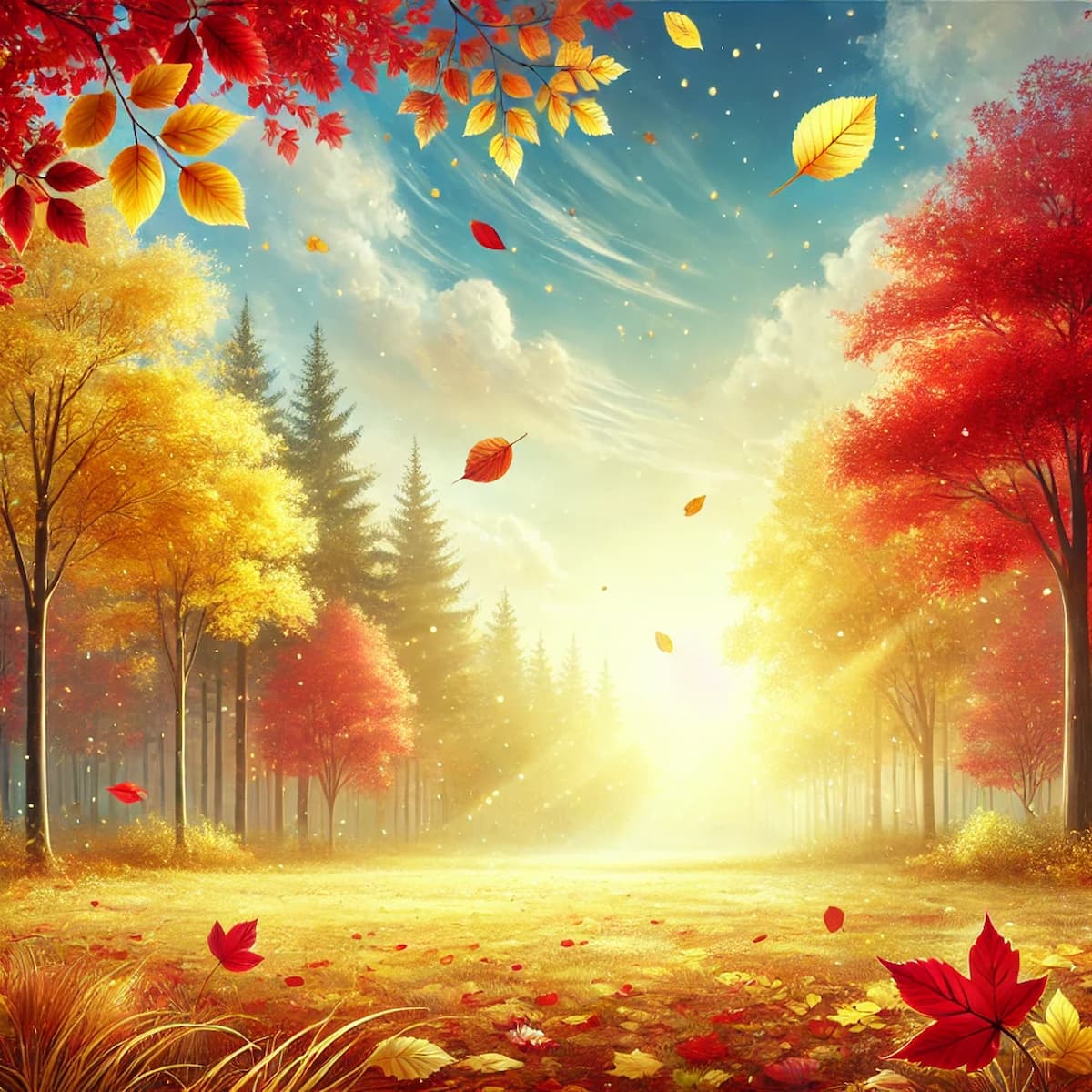
Watch short for this article (5 slides)
The Science of Senescence: Unpacking Autumn's Profound Natural Transformations
Autumn arrives with a sensory flourish – the crispness in the air, the characteristic scent of damp earth and fallen leaves, and most strikingly, the visual symphony of foliage transforming from vibrant green to a dazzling palette of reds, oranges, and yellows. Often romanticized as "Golden Autumn," this season is far more than a picturesque interlude between summer's heat and winter's slumber. It represents a period of profound ecological transition, driven by intricate biological and atmospheric processes that prepare ecosystems for the challenges ahead. Let's delve deeper than the surface beauty and explore the fascinating science behind autumn's remarkable changes in plants, animals, soil, and weather.

Photo by Isakov Eldiiar on Unsplash - Autumn is a season of critical ecological processes beneath the colorful display.
The Spectacle of Senescence: Why Leaves Change Color
The iconic transformation of deciduous leaves is perhaps autumn's most celebrated feature. This change isn't merely cosmetic; it's a carefully orchestrated biological process called senescence, triggered primarily by decreasing day length (photoperiod) and falling temperatures.
- Chlorophyll's Retreat: During the growing season, leaves are packed with chlorophyll, the green pigment essential for photosynthesis (capturing sunlight energy to make sugars). As days shorten and sunlight intensity decreases in autumn, photosynthesis becomes less efficient. Maintaining chlorophyll is energetically expensive, so trees begin to break it down and reabsorb valuable nutrients (like nitrogen and magnesium) from it back into their stems and roots for storage over winter.
- Revealing Hidden Hues (Yellows and Oranges): As the dominant green chlorophyll degrades, other pigments already present in the leaves become visible. These are mainly carotenoids (which also give carrots their color) and xanthophylls. They absorb different wavelengths of light and reflect yellows and oranges. These pigments were present all summer but masked by the abundance of chlorophyll.
- Manufacturing the Reds and Purples: Unlike yellows and oranges, the vibrant reds and purples seen in maples, oaks, and sumacs are primarily due to anthocyanins. These pigments are actively synthesized in the leaves during autumn. Their production is stimulated by sugars trapped in the leaf after the formation of an abscission layer (a corky layer of cells at the base of the leaf stalk that cuts off nutrient and water transport) and exposure to bright sunlight. Sunny autumn days coupled with cool (but not freezing) nights tend to promote the most brilliant red colors. The exact function of anthocyanins is still researched, but theories include acting as sunscreen to protect the leaf during nutrient resorption, functioning as antioxidants, or deterring pests. (Source: US Forest Service - Science of Fall Colors)
- The Final Fall (Abscission): The abscission layer eventually weakens the connection between the leaf and the stem. Wind or rain then causes the leaf to detach and fall, conserving water and preventing damage to the tree during harsh winter conditions.
The intensity and timing of fall colors vary yearly based on species, temperature fluctuations, sunlight levels, and soil moisture during late summer and early autumn.
Preparing for Winter: Animal Adaptations
As plants undergo senescence, animals respond to the same environmental cues (decreasing day length, falling temperatures, diminishing food sources) with remarkable behavioral and physiological adaptations.
- Migration: The Great Escape: Many bird species undertake long-distance migrations, traveling hundreds or thousands of miles to warmer regions with more abundant food supplies. These journeys are triggered by changes in day length detected by the bird's endocrine system, prompting hormonal changes that induce restlessness (Zugunruhe) and navigation instincts. Similarly, some mammals (like certain bat species) and insects (like monarch butterflies) also migrate. These journeys are energetically costly and fraught with peril, requiring precise navigation using cues like the sun, stars, Earth's magnetic field, and landmarks.
- Hibernation and Torpor: Conserving Energy: To survive periods of cold and food scarcity, some mammals enter a state of prolonged inactivity and dramatically reduced metabolism.
- True Hibernators (e.g., groundhogs, some squirrels, bats): Experience profound drops in body temperature (sometimes near freezing), heart rate (to just a few beats per minute), and breathing rate, conserving significant energy. They rely entirely on stored body fat and wake periodically.
- Torpor/Denning (e.g., bears, raccoons, skunks): Enter a less extreme state of inactivity. Body temperature drops less dramatically, and they are more easily aroused than true hibernators. Bears, for example, rely on accumulated fat reserves but don't experience the extreme metabolic suppression of true hibernators.
- Food Caching: Winter Larder Preparation: Animals that remain active during winter must secure food sources. Squirrels, jays, chipmunks, and others engage in intensive food caching.
- Scatter-hoarding: Hiding numerous food items (like acorns or seeds) in many different locations (e.g., squirrels burying nuts). This reduces the risk of losing the entire cache but relies on memory to relocate hidden items.
- Larder-hoarding: Storing a large quantity of food in one or a few central locations (e.g., chipmunks creating underground pantries).
- Growing Winter Coats: Many mammals shed their lighter summer fur and grow a denser, thicker coat to provide better insulation against the coming cold. Some species, like the snowshoe hare or arctic fox, also change fur color for camouflage against snow.

Food caching is a critical autumn survival strategy for many animals.
The Forest Floor: Soil Rejuvenation Through Decomposition
The shedding of leaves is far from waste; it's a critical step in nutrient cycling that sustains the entire ecosystem.
- The Leaf Litter Layer: Fallen leaves accumulate on the forest floor, forming a layer known as leaf litter or duff. This layer acts as a protective blanket, insulating the soil from temperature extremes, reducing water evaporation, and preventing soil erosion from rain and wind.
- Decomposition Engine: This litter becomes food for a vast community of decomposers – bacteria, fungi, protozoa, nematodes, earthworms, millipedes, and other invertebrates. These organisms break down the complex organic matter in the leaves through physical and chemical processes.
- Nutrient Mineralization: Decomposition releases essential nutrients (nitrogen, phosphorus, potassium, calcium, magnesium) that were stored in the leaves back into the soil in inorganic forms (mineralization) that plant roots can absorb. This replenishes soil fertility, making nutrients available for the next growing season.
- Humus Formation: The end product of decomposition is humus, a stable, dark organic material that improves soil structure, enhances water retention, and supports a healthy soil microbiome.
- Soil Cooling and Dormancy Signals: As air temperatures drop, the soil also gradually cools. This temperature change, along with decreasing day length, signals plants to enter dormancy, cease active growth, and prepare their tissues to withstand freezing temperatures. Microbial activity in the soil also slows down as temperatures fall.
Atmospheric Shifts: The Feel of Fall
The characteristic "crispness" and changing weather of autumn result from fundamental shifts in atmospheric dynamics driven by Earth's tilt and orbit.
- Decreasing Solar Radiation: As the hemisphere tilts away from the Sun after the autumnal equinox, the sun angle becomes lower, and daylight hours shorten. This means less incoming solar energy reaches the surface, leading to a net cooling effect.
- Temperature Drop: Average daily temperatures begin a noticeable decline, with greater contrast between daytime highs and nighttime lows. Nights become longer, allowing for more significant radiative cooling.
- Lower Humidity and "Crisp" Air: Cooler air holds less moisture than warmer air. As temperatures drop, relative humidity might increase if moisture levels stay the same (leading to fog or dew), but often, larger-scale weather patterns in autumn bring drier air masses (e.g., associated with high-pressure systems), leading to lower absolute humidity. This drier air contributes to the feeling of "crispness" and clearer skies often associated with pleasant fall days.
- Increased Storminess (Transition Season): Autumn is a transition season where warm, moist air masses retreating equatorward clash more frequently with colder, drier air masses advancing from the poles. This increased temperature contrast fuels the development of mid-latitude cyclones (low-pressure systems) and associated weather fronts, often leading to increased windiness, cloud cover, and precipitation compared to stable summer patterns. The first frosts and snowfalls typically occur during this season in temperate and polar regions.
- Radiation Fog: Calm, clear nights with moist air near the ground allow rapid cooling, often leading to the formation of radiation fog, especially in valleys, which typically burns off as the sun warms the surface during the day.
Autumn's Crucial Role in the Ecosystem Cycle
Autumn is not an endpoint but a vital bridge connecting the productivity of summer to the dormancy of winter and setting the stage for spring's renewal.

- Nutrient Recharge: The decomposition of fallen organic matter is essential for replenishing soil nutrients depleted during the growing season, ensuring resources are available for new growth.
- Preparation for Stress: Plant senescence and dormancy, animal hibernation and migration are all strategies evolved to survive the stresses of winter – cold temperatures, reduced sunlight, frozen water, and scarce food.
- Seed Dispersal and Stratification: Many seeds are dispersed in autumn (e.g., via wind, animal caching). Some seeds require a period of cold stratification (exposure to cold, moist conditions) during winter to break dormancy and germinate successfully in spring.
- Ecosystem Reset: Autumn processes help reset ecological interactions, influencing pest populations, clearing undergrowth (via decomposition), and preparing the physical environment for the next cycle of growth.
Conclusion: More Than Just Falling Leaves
Autumn, the "Golden Season," is a period of profound ecological significance, far deeper than its stunning visual appeal. It is a time of orchestrated retreat and preparation, driven by the predictable astronomical cycles of light and temperature. Plants undergo senescence to conserve resources, revealing hidden pigments while recycling vital nutrients back to the earth through decomposition. Animals migrate, hibernate, or cache food, employing sophisticated strategies to survive the impending scarcity and cold. The very air changes, becoming cooler and often crisper, as atmospheric dynamics shift towards winter patterns.
Understanding these interconnected processes – from the biochemistry of leaf color change to the physiology of hibernation and the microbial breakdown of leaf litter – allows us to appreciate autumn not just for its beauty, but as a critical, dynamic phase in the continuous cycle of life, death, and renewal that sustains our planet's ecosystems.